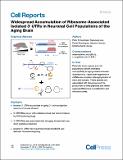Widespread Accumulation of Ribosome-Associated Isolated 3′ UTRs in Neuronal Cell Populations of the Aging Brain
Author(s)
Sudmant, Peter; Lee, Hyeseung; Dominguez, Daniel; Heiman, Myriam; Burge, Christopher B.
DownloadPublished version (5.241Mb)
Terms of use
Metadata
Show full item recordAbstract
Particular brain regions and cell populations exhibit increased susceptibility to aging-related stresses. Here, we describe the age-specific and brain-region-specific accumulation of ribosome-associated 3′ UTR RNAs that lack the 5′ UTR and open reading frame. Our study reveals that this phenomenon impacts hundreds of genes in aged D1 spiny projection neurons of the mouse striatum and also occurs in the aging human brain. Isolated 3′ UTR accumulation is tightly correlated with mitochondrial gene expression and oxidative stress, with full-length mRNA expression that is reduced but not eliminated, and with production of short 3′ UTR-encoded peptides. Depletion of the oxidation-sensitive Fe-S cluster ribosome recycling factor ABCE1 induces the accumulation of 3′ UTRs, consistent with a model in which ribosome stalling and mRNA cleavage by No-Go decay yields isolated 3′ UTR RNAs protected by ribosomes. Isolated 3′ UTR accumulation is a hallmark of brain aging, likely reflecting regional differences in metabolism and oxidative stress. Particular brain regions and cell populations exhibit increased susceptibility to aging-related stresses. Sudmant et al. report that fragments of mRNAs accumulate in the aging brains of mice and humans. These species are associated with ribosomes and the production of small peptides and reflect regional differences in metabolism and oxidative stress.
Date issued
2018-11Department
Picower Institute for Learning and Memory; Massachusetts Institute of Technology. Department of BiologyJournal
Cell Reports
Publisher
Elsevier BV
Citation
Sudmant, Peter H. et al. "Widespread Accumulation of Ribosome-Associated Isolated 3′ UTRs in Neuronal Cell Populations of the Aging Brain." Cell Reports 25, 9 (November 2018): P2447-2456.e4. © 2018 The Authors
Version: Final published version
ISSN
2211-1247